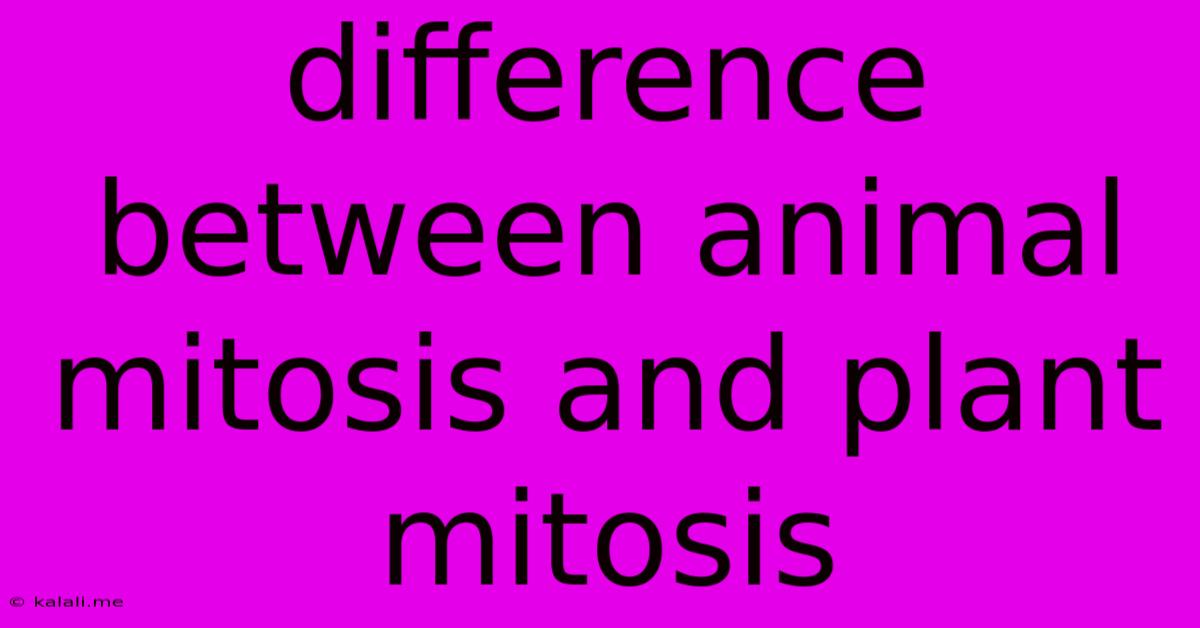Difference Between Animal Mitosis And Plant Mitosis
Kalali
Jun 12, 2025 · 3 min read

Table of Contents
The Great Divide: Exploring the Key Differences Between Animal and Plant Mitosis
Mitosis, the process of cell division resulting in two identical daughter cells, is fundamental to life. While the overall process is similar in both plants and animals, several key differences exist, stemming from the structural variations between plant and animal cells. Understanding these differences is crucial for grasping the intricacies of cell biology. This article will delve into the key distinctions between animal and plant mitosis, focusing on the unique challenges and adaptations each faces during this crucial cellular process.
The Similarities: A Shared Foundation
Before highlighting the differences, it's important to acknowledge the similarities. Both animal and plant mitosis follow the same basic phases: prophase, prometaphase, metaphase, anaphase, and telophase, all culminating in cytokinesis. In both cases, the goal is to accurately duplicate and segregate the chromosomes, ensuring each daughter cell receives a complete set of genetic material. The fundamental mechanisms of chromosome condensation, spindle formation, and chromosome movement are conserved across both kingdoms.
Key Differences: Where the Paths Diverge
Despite their shared foundation, several significant differences distinguish animal and plant mitosis. These differences primarily relate to the structural components of the cells themselves and the resulting mechanisms of cytokinesis.
1. Cytokinesis: The Defining Distinction
This is perhaps the most significant difference. Animal cells undergo cytokinesis through a process called cleavage furrow formation. A contractile ring of actin filaments forms beneath the plasma membrane, constricting the cell from the outside and pinching it into two daughter cells. Think of it like tightening a drawstring bag.
Plant cells, however, possess a rigid cell wall. This rigidity prevents the formation of a cleavage furrow. Instead, plant cytokinesis involves the construction of a cell plate in the middle of the cell. This cell plate, derived from Golgi-derived vesicles containing cell wall materials, gradually expands outwards, fusing with the existing cell wall to create a new cell wall between the two daughter cells. This process builds a new cell wall, effectively partitioning the cell.
2. Role of the Centrosome:
The centrosome, an organelle that organizes microtubules, plays a vital role in animal cell mitosis. It duplicates and migrates to opposite poles of the cell, forming the spindle poles and organizing the mitotic spindle. While plants also utilize microtubules for spindle formation, they typically lack well-defined centrosomes. Instead, microtubules organize and form the spindle apparatus from other sites within the cell.
3. Cell Wall Formation (Plants Only):
As mentioned, cell wall formation is unique to plant mitosis. The formation of the cell plate and its subsequent development into a new cell wall are complex processes involving the precise delivery and deposition of cell wall components, ensuring the structural integrity of the new cells. This process is absent in animal cells.
4. Golgi Apparatus Activity:
The Golgi apparatus plays a more significant role in plant cell mitosis due to its involvement in cell plate formation. It actively produces and transports the vesicles containing pectin, cellulose, and other components necessary for building the new cell wall. This activity is less pronounced in animal cell mitosis.
Conclusion: Two Sides of the Same Coin
While animal and plant mitosis share the fundamental goal of accurate chromosome segregation, their mechanisms differ significantly, primarily due to the presence of a cell wall in plant cells. These differences highlight the remarkable adaptability of the mitotic process, showcasing how it has evolved to meet the specific needs of diverse cell types and organisms. Understanding these nuances provides a deeper appreciation for the complexity and elegance of cellular processes.
Latest Posts
Latest Posts
-
Example Of Static Friction In Real Life
Jun 13, 2025
-
The Horizontal Row O The Periodic Table Name
Jun 13, 2025
-
Mass Of A Proton In G
Jun 13, 2025
-
Least Common Multiple Of 14 And 12
Jun 13, 2025
-
Which Of The Following Statement Is Not True
Jun 13, 2025
Related Post
Thank you for visiting our website which covers about Difference Between Animal Mitosis And Plant Mitosis . We hope the information provided has been useful to you. Feel free to contact us if you have any questions or need further assistance. See you next time and don't miss to bookmark.